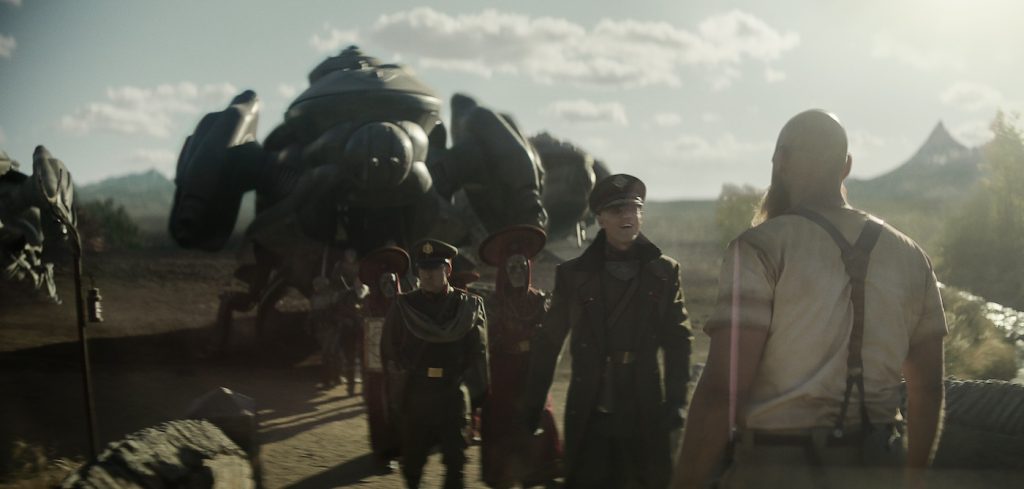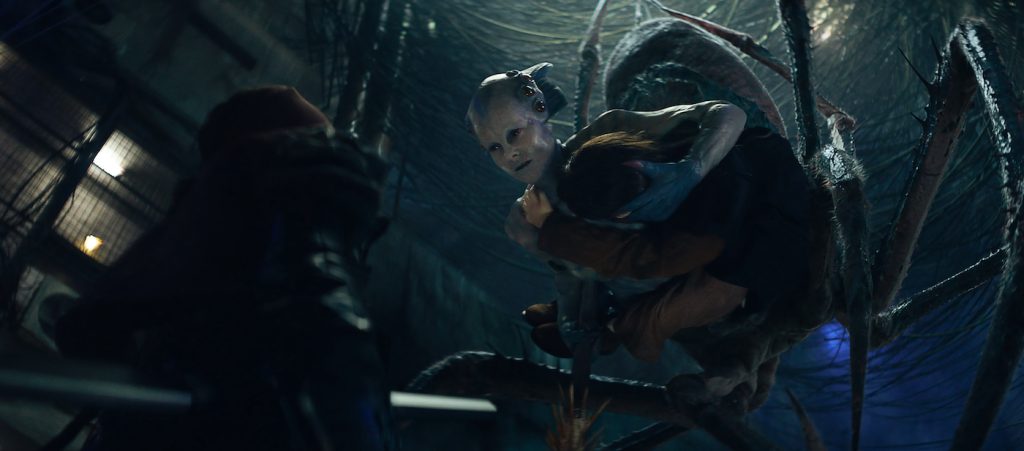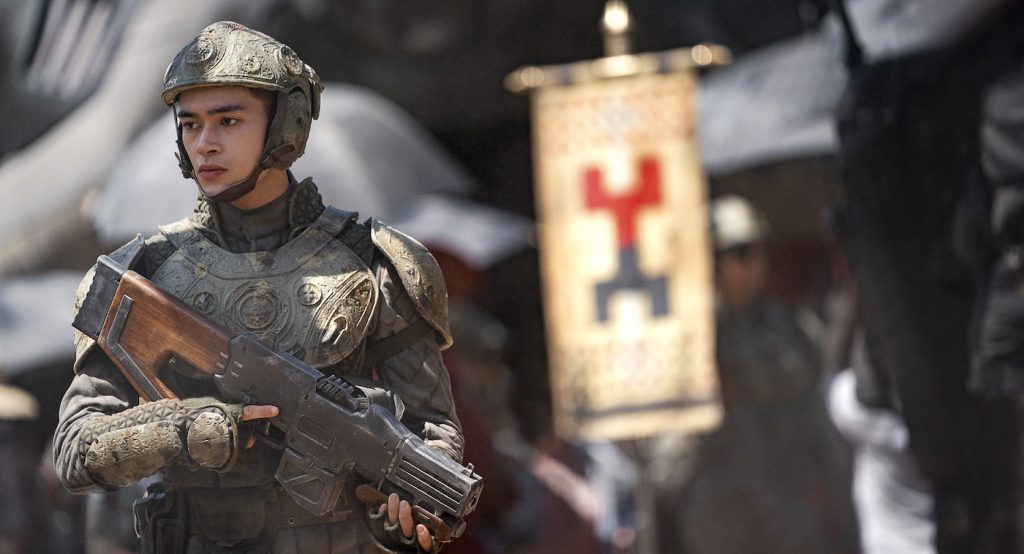“Rebel Moon” Sound Editors on Creating Different Sonic Worlds for Zack Snyder
Part one of director Zach Snyder’s Netflix space epic, Rebel Moon — A Child of Fire, opens on a quaint farming community on a peaceful moon called Veldt. Hard at work in the fields, Kora (Sofia Boutella) is clearly not of this community of self-styled Luddites, and the evil Imperium she’s escaping soon catches up with her. A massive ship alights above Veldt’s rolling fields, dropping Atticus Noble (Ed Skrein) and a band of soldiers onto the moon to commandeer the farmers’ grain stores and disturb their bucolic way of life forever.


To save her adopted community, Kora takes off with Gunnar (Michiel Huisman), a farmer, to gather an intergalactic band of outcast warriors, from fallen general Titus (Djimon Hounsou) to the surgical assassin Nemesis (Bae Doona). Hopping from planet to planet with the help of Kai (Charlie Hunnam), a suspiciously interested n’er-do-well, Kora’s efforts take her from industrial hellscapes to lands reminiscent of ancient Rome. Supervising sound editors Scott Hecker and Chuck Michael gathered their team at Studio Formosa in Santa Monica to collaborate in person.
“This was my ninth adventure with Zach, and Chuck has been on the last five. Through the years, we’ve created a shorthand with Zach,” Hecker said. “Obviously, he’s got his ideas, but he wants to always give you the first opportunity to be creative. Then, once he has something to hear, we can start talking about that sound instead of talking in the ether.”
What was key on Rebel Moon was designing worlds that stood apart from each other but which fit together within director Snyder’s idea of a sci-fantasy, rather than a straight sci-fi epic. We spoke with Hecker and Michael about what that meant for iterating individual sounds, the realistic sources they turn to for intergalactic effects, and the details that made different worlds stand apart.
The film moves from planet to planet. Is it a priority to use sound to delineate between each world, or do you focus on creating a through-line for all of them?
Scott Hecker: We went to great lengths to make sure that each of the planets that we visited throughout the film sounded distinct. They were visually a bit different, so that helped us. Planet Dagus, where we met the spider character, Harmada [Jena Malone], looked very industrial and Blade Runner-like. Veldt is a very natural farming community, and it’s a moon. So we went to great lengths to make sure all the atmospheres had a flavor and personality of their own.

Chuck Michael: And not just the atmospheres, but even the weapons on Veldt have a different quality to them than the Imperium weapons. The weapons on Veldt include realistic guns with less of a high-tech, futuristic sound, whereas the Imperium weapons are much more sophisticated. And so not only did we try to change the environments and the backgrounds, but also the tech. Everything you hear hopefully fits in with the world in which it exists.

Where do you source sounds? And what are some resources you used that might surprise the audience?
Hecker: We just went to each of those planets and recorded the atmospheres. No, that was the fun of it. We react to the visual stimuli we’re presented with, and Zach serves it up in spades. He’s such a great visionary. The looks of all these planets are just spectacular, so it made it a lot easier for us to attach flavors and textures of atmospheres for each environment.
Michael: As for unique things, there’s the giant bird, the bennu. It’s all processed and changed, so you wouldn’t recognize what the source is, but a lot of it’s based on elephants and raccoons. We always have to start with something in the real world. For weapons, you can layer on synthetic sounds, but the weapons are based on actual weapons. I think part of the trick of sound design is trying to figure out not what the actual sound is but what it should sound like and what you can take as a source and manipulate. A lot of times, when I’m looking at that source, I’ll try to figure out what has the emotion I want. So with Kai’s freighter, I wanted weight and power, and a freight train says that. That freighter is probably thirty elements of different things at different times, including an eagle screech. It’s just a matter of finding something that gives you the right feeling and emotion and then adding cool elements on top of it, but we always start with something realistic.
Michael: And also, many people might refer to Rebel Moon as a sci-fi film, but Zach would refer to it as a sci-fantasy film, and that helped us work through some of our sounds. We were coming up with zippy, synthetic sounds, and as soon as Zach heard a couple of things where we may have made it sound too sci-fi-like, he said he wanted the sounds to be more grounded, organic, natural, and steampunk, sort of old but new. Unusual sounding, but still familiar and not completely synthetic.
Can you give me an example of something that required a few iterations to get right?
Hecker: There are a couple. In the brothel, which people probably refer to as the bar scene, there’s the gentleman that the bug is speaking through with a processed voice. I think we ended up experimenting with up to eight different versions of that. Then also the swords, which Zach refers to as photon-foils. We worked quite a bit on different swords. And the bell Kora rings on Veldt with a mallet; we went through quite a few iterations of that. We got to a point where I said, let’s just do an internal bake-off. Everyone, come up with your own version of this bell. We presented them to Zach…
Michael: …and what you hear is what he decided. The other attempts we did all had something edgy, and that was the purest version, which makes sense on the planet of Veldt.
Were there any major sci-fi tropes you were trying to avoid?
Hecker: In general, all of them. I think it was very freeing for us once Zach said he didn’t want it to sound too sci-fi. The dreadnaught, the mothership of the Imperium, looked like a city-sized submarine. Once you cut inside, we ended up using sonar pings.
Michael: But futuristic. You’d realize they’re sonar, but not exactly sonar.
Hecker: And really garbled radio communications, with processed animal chittering laced in. We took an opportunity to keep it more natural-sounding but with a more sci-fantasy feel and not a sci-fi feel.
Michael: And the guns are very much based on big, powerful explosions, but they have charge-ups and sci-fi elements to them. All the elements wrapping it up are sci-fi, but the core element is recognizable.
Hecker: We didn’t want it to sound like ‘pew pew.’ Zach likes a robust, bravado sound. Anytime anyone is threatened with a weapon, you hear a charge-up sound. Not only is it associated with the weapon itself, but it helps ramp up the tension as well. It was a good balance of powerful, natural gun sounds with a little bit of sci-fantasy flavor in there.
In terms of the music, do you work closely with the composers to layer that in?
Hecker: We have initial conversations, but at the end of the day, you have to walk away and do what you have to do. We’re preparing everything as if the film was going to play without music, and we try to be artful and stylized in that endeavor as well. I think it is cool the way Tom Holkenborg’s score melds with our sound design tones and elements. We worked on that balance. There are a lot of loud sounds, and Tom’s score is really powerful and dense. We were really challenged to try to articulate from scene to scene, to hand off here and there.
Michael: And a lot of that credit goes to our mixers, Andy Koyama and Martyn Zub, who balanced all that together and made it play well. You get into a situation where you put the two together, and it can sound dense and unclear because everybody is trying to do the same thing, so we always try to strip away anything that is not helping tell the story just to give clarity. We want to make sure we focus on the sounds that help communicate that this person just got shot, or this person almost got hit, or the big ship is coming down. It’s a delicate dance. We’ll even cut a new effect in a different frequency range if something is not coming through. If you just make it louder, it’s just pain, so what you want is to find the frequencies that can help tell the story.
Rebel Moon – Part One: A Child of Fire is streaming on Netflix. Part Two: The Scargiver premieres on Netflix on April 19.
Featured image: Rebel Moon. (Featured) Staz Nair as Tarak, Sofia Boutella as Kora, Michiel Huisman as Gunnar and Charlie Hunnam as Kai in Rebel Moon. Cr. NETFLIX ©2023



